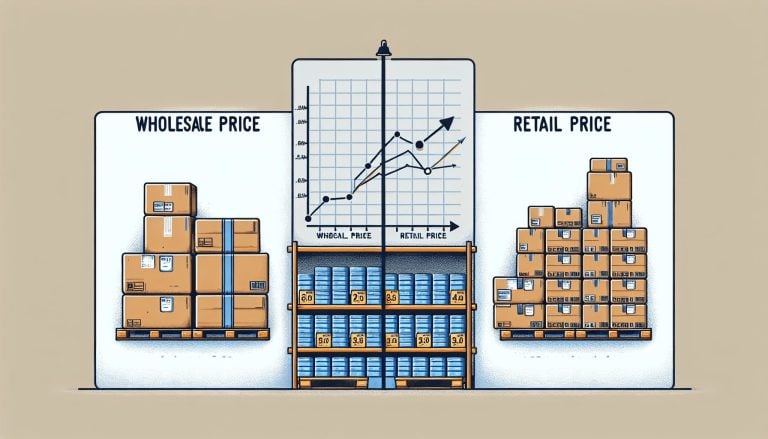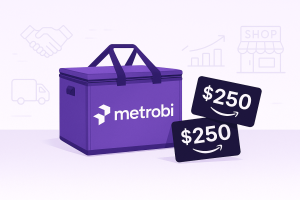Wholesale price vs retail price is what we learn today.
Ever found yourself in a warehouse store, comparing bulk packages to your usual retail-brand favorites, and wondered about the price difference? You’re not alone.
Understanding the difference between wholesale and retail prices reveals a lot about business strategies and consumer habits. Just like how Starbucks made an everyday commodity like coffee into a special experience worth paying extra for, setting retail prices is a skill developed over many years.
There’s an important truth in the story of how prices are set and profits are made. This truth might change how you see prices. Welcome to a straightforward look at wholesale versus retail prices.
Retail's Big Leap
Retail industry is increasing year by year. Experts get ready for a jump to $31.1 trillion in sales by 2024, as the shopping world grows fast, hitting $34.9 trillion by 2027!
Metrobi drivers are rated 4.97/5
Trusted by local businesses for:
- Background-checked professionals
- Specialized in business deliveries
- Same drivers for consistency
- 4.97/5 average delivery rating
What is the difference between wholesale price vs retail price?
Defining Wholesale Price: The First Step to Understanding
Understanding the intricate world of pricing begins with an exploration into the concept of wholesale prices. Generally, this can be defined as the cost that a manufacturer or producer charges a retailer for their goods. It’s the initial pricing point, before any markups are added. In considering the approach to adopt for your business, evaluating the differences in retail vs wholesale pricing strategies, including how each affects profit margins, inventory levels, and customer base, is essential.
Wholesale price demonstrates the exact cost for production and distribution of the goods, excluding any additional expenses such as marketing, rent, or storage fees. Thus, it only reflects the essential costs from production to the point-of-sale system in the retailer’s inventory, making it a vital benchmark in the pricing journey. At Metrobi, our dedicated service seamlessly facilitates the delivery of wholesale goods, ensuring an efficient distribution process for wholesalers.
A crucial aspect to bear in mind is that wholesale prices tend to be lower due to the large quantities being sold at a time. This enables the retailer to purchase goods at a discounted rate which in turn aids them to make their profit. Understanding the distinctions between wholesale and retail operations is vital for selecting the most suitable business model for success.
Beverages on the Fast Track!
Beverage industry is making a splash, expected to grow at a speedy 3.5% rate from 2024 to 2030, fueled by our love for drinks bought outside of bars and restaurants.
Retail Price: The Final Step in the Pricing Journey
Once the wholesale price has been established, its subsequent augmentation leads to the final retail price. Essentially, this is the price the end consumers will pay for the product.
Importantly, retail price isn’t formulated in a vacuum. It reflects a variety of factors besides the original wholesale cost. These include costs associated with running a retail business such as rent, wages, marketing, and overall profit margins that the retailer hopes to gain from the sale of the product. The retail price therefore signifies the cumulative value of the product to the final consumer, wrapping the product’s journey from producer to retailer neatly.
But there’s more to the retail price story. Retailers strategically set these prices to align with their targeted consumer sector. They factor in the perceived value of their product, the purchasing power of their consumers, and competition in the market – all of which plays an integral role in determining the final retail price.
The Rise of Home Chefs!
In 2023, the food cupboard segment dominated the food & grocery retail market, shining bright thanks to our newfound passion for home cooking and baking.
The Gap between Wholesale and Retail Price: Why Does It Matter?
The gap between wholesale and retail prices, often referred to as the markup, is where businesses gain their essential profits. It represents the difference between the cost of obtaining the product and the final selling price.
This gap is essential as it allows businesses to cover overhead costs, keep their doors open, and generate profit. Additionally, it cushions businesses against fluctuations in production and shipping costs that can significantly eat into their profits if not adequately accounted for.
Moreover, understanding this gap is key for businesses to strategize their pricing methods effectively. They can adjust the size of the markup based on their operational expenses, competitive situation and the perceived value their products hold for customers.
Getting familiar with the mechanisms of wholesale and retail pricing isn’t merely academic knowledge. It is a fundamental aspect of running a successful business that reflects the financial health and survival of companies in the fiercely competitive market arena. Whether you are a manufacturer, a retailer, or even an end-consumer, being aware of these pricing nuances is a key business asset.
Unpredictable Shifts in Food Market Margins
Experiencing volatility over 5% in monthly changes, grocery wholesalers and retailers navigate the unpredictable waters of market margins.
Metrobi is transforming wholesalers deliveries
Specialized solutions for wholesalers businesses:
- Wholesalers-trained drivers
- Proper handling equipment
- Peak day delivery support
- 23% average cost reduction
The Art of Calculating Wholesale and Retail Prices
Step 1: Understanding the Components of Wholesale Price
Wholesale pricing is not a random number plucked out of thin air. It’s a thoughtful estimation derived from several cost components. The first of these is the cost of production. Metrobi aids these wholesalers by offering delivery services across over 20 cities in the US, encompassing courier services in Miami.
Starting from raw materials to labor expenses, manufacturing overheads, and even the cost of delivery to the wholesale outlet – every single expense in the entire production process adds to the cost of the goods. Each unit product’s cost is calculated by spreading these cumulative expenses over the total output produced. At Metrobi, our expertise in managing wholesale delivery operations offers an efficient solution for reducing delivery costs, ultimately benefiting wholesalers by optimizing their overall expenses.
Next, we have the wholesaler’s profit margin, which essentially is their operational cost plus a little extra to ensure their efforts are worthwhile. This too piles up on the total wholesale price, making it a joint culmination of production cost and the wholesaler’s markup.
Step 2: The Formula for Calculating Wholesale Price
Understanding the formula that calculates wholesale prices can give you an upper hand in negotiations. The essential formula for this is:
Wholesale Price Formula
Simply: Wholesale Price = Production Cost + Profit Margin
Example: If the production cost is $50 and the profit margin is $10, then the wholesale price would be $60.
Step 3: Retail Markup Calculation: The Key to Profit
How much you markup the wholesale price once the product hits your retail store largely dictates your retail business’s profitability.
Retail Markup Simplified
Retail Price = Wholesale Price × (1 + Markup)
Example: $20 wholesale with 75% markup = $20 × 1.75 = $35 retail.
The Impact of Wholesale Price on Retail Price: A Closer Look
How Wholesale Price Influences Retail Price
As a catalyst, the wholesale pricing has an undeniable influence on retail pricing. It’s not rocket science; the cost at which retailers procure goods from wholesalers ultimately sets a baseline for retail prices. If wholesalers hike their prices, retailers respond in kind to maintain their profit margins. At Metrobi, we aid these wholesalers by offering delivery services across more than 20 US cities, including providing courier services in Baltimore, ensuring their operations run smoothly and efficiently.
Supply and demand play an integral role too. In a perfect market, a glut in supply leads to decreased wholesale and subsequently retail prices. On the other hand, a scarcity could push prices upwards. This interplay illustrates a fundamental principle of economics, coupling the destinies of wholesale and retail prices.
The Role of Market Conditions in Determining Prices
Market conditions wield an extraordinary power in determining both wholesale and retail prices. And it’s far from just supply and demand. Inflation rates, economic forecasts, business competition, and customer buying behavior all weave into the complex tapestry of market conditions.
During economic boom periods, consumers are generally willing to part with more cash, which inevitably leads to markups in prices. If the situation is reversed, and the economy hits a lull, price becomes a sensitive factor – and often sees a downturn.
Decade of Rising Meat Prices
Since 2000, Choice beef prices have seen a consistent uptrend, with pork prices joining the rise in 2012. Remarkably, beef hit a peak retail price of $6.41 per pound in early 2015.
The Effect of Supply Chain Costs on Wholesale and Retail Prices
While wholesale prices influence retail prices, they are subject to the cost pressures of the supply chain. Everything from raw material costs, labour, transportation, storage and even the costs of complying with regulations factor into the final wholesale pricing. These costs are then passed on to retailers, driving up the retail prices.
With the advent of the global economy, these cost factors have grown in complexity. Shocks in the supply chain, geopolitical issues or macroeconomic shifts can all alter the cost landscape.
In conclusion, understanding the impact of wholesale pricing on retail pricing, the role of market conditions and supply chain costs comes in handy. This knowledge lays a solid foundation when setting wholesale prices and helps in predicting the possible pricing trajectory in your retail market.
Wholesale Pricing Strategy: The Backbone of Profitable Business
The Importance of a Sound Wholesale Pricing Strategy
A sound wholesale pricing strategy serves as your financial compass, guiding every business decision and shaping your company’s future profitability. It’s no exaggeration to deem it as the backbone of a profitable business; it’s pivotal for every company dealing in the wholesale market to establish a logical, scalable, and robust pricing strategy. A well-crafted and implemented wholesale pricing strategy can help you avoid the pitfalls of pricing too high or too low. If you price too high, you risk turning off potential customers; pricing too low on the other hand can severely limit your profit margins and potentially devalue your product in the market. Understanding how to position your products properly within the market is the first step towards establishing a sound wholesale pricing strategy.
Soaring Food Prices in 2022
In 2022, an unprecedented increase in food prices was observed, with food-at-home prices surging by 11.4% and food-away-from-home by 7.7%.
Key Elements of a Successful Wholesale Pricing Strategy
Successful wholesale pricing strategies aren’t just pulled out of a hat; they’re carefully crafted and consist of several key elements. Knowing your costs, understanding customer’s value perception, competitive analysis, and price testing – these are the building blocks of any effective wholesale pricing strategy.
Knowing your ‘costs’ is essential because it forms the foundation of your pricing strategy. It’s not just about the dollar value you invest in product creation: you should consider other factors like operational overheads, shipping, taxes, and post-sale service costs.
Understanding how your customers perceive the value of what you’re selling is equally important. Remember, in a business-to-business (B2B) environment, you’re selling to professionals who understand the market and value proposition. An appreciation of their perspective can help you justify your pricing while underscoring the unique value of your products.
Competitive analysis involves studying the pricing strategies of your competitors. Learning from their pricing structure can provide insights on how to position your products within the market.
Lastly, price testing is an ongoing process that allows real-time feedback on your pricing strategies. Adjustments based on customer behaviors and market conditions are crucial to stay responsive and competitive.
Case Study: Successful Wholesale Pricing Strategies in Action
Consider Dell Technologies — a B2B wholesaler who managed to turn their fortunes around by implementing a successful wholesale pricing strategy.
Their first step was to conduct a thorough cost audit, followed by an in-depth market research to understand the customers’ perception of their products’ value. With these insights, Dell Technologies was able to set realistic prices that reflected real value for their customers, while ensuring profitability for their business.
By also paying attention to their competitors’ pricing strategy, Dell Technologies could position themselves as a value-driven alternative in the market. Regular price testing and adjusting their prices based on feedback and market fluctuations ensured they always stayed on top of their pricing game.
In their case, Dell Technologies wanted to improve its pricing inefficiencies, win rates, and profitability. By turning to dynamic pricing software after reviewing their pricing and quoting strategy and identifying opportunities for improvement, they achieved fast, efficient quoting, including an increase in quote velocity to just four hours for 90% of deals, optimized pricing with strategic guidance that boosts win rates and profitability, and improved sales effectiveness. This approach not only allowed Dell to set prices optimized for increasing win rates but also to generate quotes faster for customers and improve overall efficiency.
Asia Pacific Leads the Way
In 2023, Asia Pacific took the crown in the food & grocery retail world, boasting a 36.6% share of global revenues. This surge is thanks to more supermarkets popping up in developing nations and folks having more money to spend.
Wholesale to Retail Markup: Maximizing Your Profit Margins
Understanding the Concept of Markup in Retail
We all know the buying low and selling high axiom as the fuel for any profitable business. It could very well be the holy grail of success in every trade!
In the retail world, when you purchase goods at a wholesale cost and sell it at a higher retail price, the difference between the two is what we call ‘markup’. All signifies margins of profit you make for every product sold. Valuing your markup accurately can utterly reshape your profit arena, allowing you to sustain, grow, and prosper your retail business.
The price per item is a critical metric for both wholesale buyers and retail buyers, influencing the product prices that ultimately shape the purchasing decisions of the retail customers. Understanding the price retailers set is pivotal in attracting a diverse customer base, which is often segmented by buyer demographics and the potential buying power of potential buyers.
Feedback mechanisms, such as customer feedback, play a vital role in adjusting these prices to meet market expectations and enhance satisfaction among retail customers. For wholesale profit margin and healthy profits to coexist, businesses must keenly manage inventory costs, possibly leveraging inventory management software to streamline operations. This approach is especially relevant in a B2B business context, where eCommerce business models and individual sales strategies can significantly influence the cost of sale and the overall product sales. Effective management of these elements ensures a robust profit percentage, underscoring the importance of volume of sales as a metric for assessing business health and strategic direction.
How to Calculate Your Ideal Markup
Crackling the markup puzzle is like striking gold. So, how do you do it?
Unlock the Retail Magic: The Markup Formula
Retail Price = [Cost of Item / (100 - Markup Percentage)] * 100
Imagine you have an item costing $20, marked up by 50%. Apply the formula, and your retail shines at $40!
Use this formula across your product range to summon a uniform and reasoned pricing approach. Remember, your markup isn’t just about making profits. It’s also about shielding your business against future pitfalls or surprises.
Tips for Setting a Profitable Markup
Building a profitable markup strategy is an art that combines numeric facts with niche instincts. Here are some tips to help:
Analyze the market: Gaining a pulse of the market is executive to forecasting real-time demands, competitor pricing, and customers’ willingness to pay. Threading these insights together can develop a cohesive markup strategy that ticks all profitability boxes.
Know your operating costs: Your markup needs to cover more than just your item’s cost. It should absorb overhead costs like rent, salaries, utilities, and shipping. Knowing these help to set a grounded, realistic markup that caters to all business expenses.
Consider your branding: High-end products or luxury brands can often command higher markups due to the perceived value of the brand or product quality. Carefully consider your brand positioning when setting your markup.
Stay open to revisions: Stay nimble: market trends, seasonal swings, or even a global pandemic can necessitate mar
The Bigger Picture: Wholesale and Retail Prices in the Market Economy
The Role of Wholesale and Retail Prices in the Economy
Wholesale and retail prices are like the hidden puppet masters of the market economy. Not only do they dictate what items cost, but they also indirectly influence the buying behaviors of both businesses and consumers. In turn, these behaviors impact the broader economic activity. High wholesale prices might discourage retailers from purchasing and consequently shrink their stock levels. Lower retail prices could stimulate consumer spending, providing a temporary boost to the economy. Moreover, these prices have a domino effect – from impacting producer decisions to swaying international trade relations.
How Market Trends Influence Wholesale and Retail Prices
Wholesale and retail prices don’t exist in a bubble. They ebb and flow with the tides of market trends. Both are susceptible to a host of factors such as supply and demand fluctuation, policy changes, and current events. For instance, an increase in demand or decrease in supply (say due to resource scarcity) can drive up both wholesale and retail prices. Conversely, developments such as technological advancements or economic recession might force these prices down.
Retail prices also reflect market competition. Companies may lower their retail prices to stay competitive, hence directly affecting consumer behavior. All in all, market trends act like a compass, guiding the directions of wholesale and retail prices.
Future Predictions: The Evolution of Wholesale and Retail Pricing
In the fast-paced world of business, the only constant is change – and wholesale and retail pricing are no exceptions. Intricately intertwined with the realms of consumer behavior, technological advancements, and global economics, these pricing models will continue to adapt and evolve.
Emerging technologies, such as artificial intelligence and machine learning, are already reshaping the pricing landscape. They enable real-time, dynamic pricing strategies based on a myriad of variable factors. Not to mention, the growth of e-commerce has added an entire new dimension to retail pricing, adding more competitive transparency and consumer power.
In the backdrop of these developments, one thing is certain: the future of wholesale and retail pricing is neither static nor predictable. Only time will unravel the intricacies of this evolution.
North America's Growing Appetite
The North America food & grocery retail sector, led by the U.S., hit a whopping USD 1,872.4 billion in 2023, and it's not stopping there. With a growth rate of 2.4% expected from 2024 to 2030, the appetite for more is only getting bigger.
Conclusion
The bitter truth unveiled – wholesale pricing isn’t always less expensive and retail isn’t always more profitable. But remember, the key to unlocking business profit lies in the delicate balance of both. Have a firm grasp on wholesale and retail pricing and you are steering toward the path of sustainable business growth.
Now, it’s time to put the knowledge to the test. Carefully assess your current pricing strategy. Are you missing out by following the age-old belief of a ‘wholesale-buy, retail-sell’ tactic? Could a careful mix of both provide a better return?
How well do you really know your wholesale and retail prices? Are you prepared to question traditional practices and flip the system where it advantages you? Are you considering engaging in both wholesale and retail aside from the traditional retail route to expand your market reach and profitability?
Just remember, every penny you lose in the price game, is a penny you could have taken to the bank. Find that balance, solidify your strategy and make every cent work for your business. Stand tall in the marketplace, with the power of right pricing on your side.














